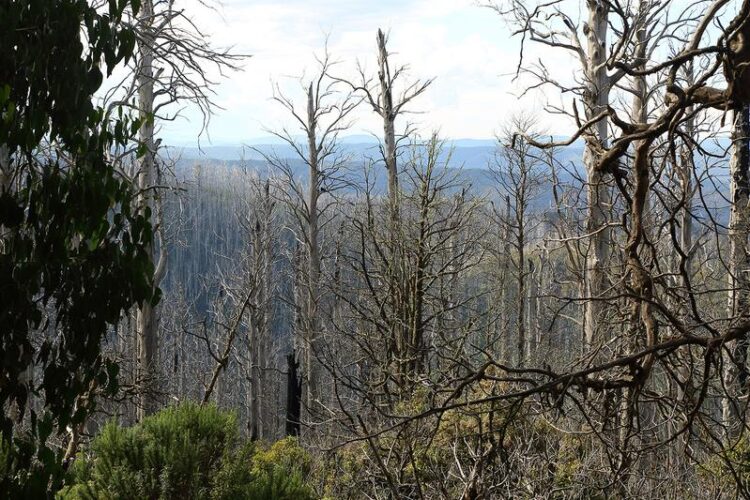Halt post-disturbance logging in forests

Burned eucalypt forest in Australia. Avoiding overall post-disturbance logging after such major disturbances can help to maintain biodiversity.
Photo: Simon Thorn / University of Wuerzburg
Storms, fires, bark beetles: Many forests around the world are increasingly affected by these and other natural disturbances. It is common practice to eliminate the consequences of these disturbances – in other words, to harvest damaged trees as quickly as possible. Spruce trees attacked by bark beetles are removed from the forest, as are dryed beeches or trees thrown to the ground by storms.
“However, this practice is an additional disturbance that has a negative impact on biodiversity,” says Dr. Simon Thorn, forest ecologist from Julius-Maximilians-Universität (JMU) Würzburg in Bavaria, Germany. During such logging operations, soil is damaged, most dead wood is removed and structures such as folded up root plates are lost. “That is why a certain proportion of such disturbed forests should be excluded from overall logging operations,” Thorn says.
Evidence-based benchmarks calculated for the first time
Forests in which natural disturbances are preserved without human intervention are among the most threatened habitats in the world. “Up to now, there have been no evidence-based benchmarks on what proportion of land in a naturally disturbed forest should be left in order to promote the biodiversity of plants, birds, insects and fungal species ” says the JMU scientist.
To close this gap, an international research team led by Simon Thorn has analyzed data global dataset on natural forest disturbances. In the journal Nature Communications, the scientists conclude that if around 75 percent of a naturally disturbed forest area is not cleared, 90 percent of its original species richness will be preserved. If only half of a disturbed forest is left untouched, around a quarter of the species will be lost. “These numbers can serve as a simple rule of thumb for leaving natural disturbances in forests unlogged,” says Thorn.
Media Contact
All latest news from the category: Ecology, The Environment and Conservation
This complex theme deals primarily with interactions between organisms and the environmental factors that impact them, but to a greater extent between individual inanimate environmental factors.
innovations-report offers informative reports and articles on topics such as climate protection, landscape conservation, ecological systems, wildlife and nature parks and ecosystem efficiency and balance.
Newest articles

Silicon Carbide Innovation Alliance to drive industrial-scale semiconductor work
Known for its ability to withstand extreme environments and high voltages, silicon carbide (SiC) is a semiconducting material made up of silicon and carbon atoms arranged into crystals that is…

New SPECT/CT technique shows impressive biomarker identification
…offers increased access for prostate cancer patients. A novel SPECT/CT acquisition method can accurately detect radiopharmaceutical biodistribution in a convenient manner for prostate cancer patients, opening the door for more…

How 3D printers can give robots a soft touch
Soft skin coverings and touch sensors have emerged as a promising feature for robots that are both safer and more intuitive for human interaction, but they are expensive and difficult…





















